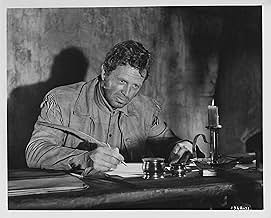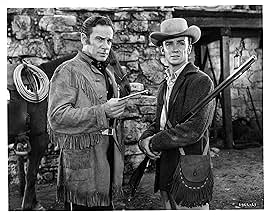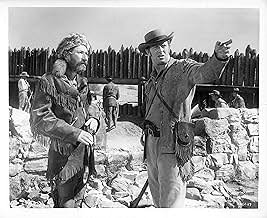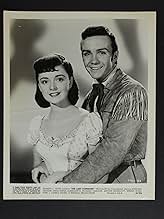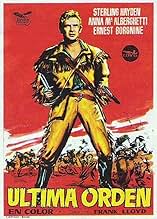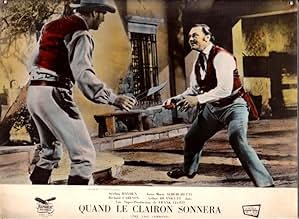IMDb रेटिंग
6.2/10
1 हज़ार
आपकी रेटिंग
अपनी भाषा में प्लॉट जोड़ेंModerate Jim Bowie leads rebellious Texicans--and Davy Crockett--in a last-ditch stand against his old friend, Santa Ana.Moderate Jim Bowie leads rebellious Texicans--and Davy Crockett--in a last-ditch stand against his old friend, Santa Ana.Moderate Jim Bowie leads rebellious Texicans--and Davy Crockett--in a last-ditch stand against his old friend, Santa Ana.
- निर्देशक
- लेखक
- स्टार
Abdullah Abbas
- Townsman
- (बिना क्रेडिट के)
Rico Alaniz
- Tomas
- (बिना क्रेडिट के)
फ़ीचर्ड समीक्षाएं
Frank Lloyd's career stretched back to the silent era--he was a major director and made films for the top studios in Hollywood. Winding up at a B studio like Republic would seem to be a step down the career ladder, but this film is actually one of Lloyd's best and one of the best to ever come out of Republic.
The studio didn't often get the services of directors of the calibre of Frank Lloyd--although John Ford and Fritz Lang had occasionally made films there--and it spared no expense on this one. The subject matter demanded a big budget, and Republic didn't stint. Thousands of extras, big sets, spectacular action scenes, robust performances--all combined to make a first-rate action picture. Sterling Hayden makes a good Jim Bowie, the always underrated Arthur Hunnicutt personifies Davy Crockett, and the cast is filled with familiar character actors--Roy Roberts, Slim Pickens, John Russell, Jim Davis--who contribute much to the overall atmosphere of the film. The setpiece of the movie, though, is the final siege of the Alamo itself, and it is spectacular. It compares well to the John Wayne version made five years later, and ranks right up there with the final battle scene in 1964's "Zulu"--expertly edited with top-notch stunt-work and special effects. Very highly recommended.
The studio didn't often get the services of directors of the calibre of Frank Lloyd--although John Ford and Fritz Lang had occasionally made films there--and it spared no expense on this one. The subject matter demanded a big budget, and Republic didn't stint. Thousands of extras, big sets, spectacular action scenes, robust performances--all combined to make a first-rate action picture. Sterling Hayden makes a good Jim Bowie, the always underrated Arthur Hunnicutt personifies Davy Crockett, and the cast is filled with familiar character actors--Roy Roberts, Slim Pickens, John Russell, Jim Davis--who contribute much to the overall atmosphere of the film. The setpiece of the movie, though, is the final siege of the Alamo itself, and it is spectacular. It compares well to the John Wayne version made five years later, and ranks right up there with the final battle scene in 1964's "Zulu"--expertly edited with top-notch stunt-work and special effects. Very highly recommended.
Studio politics prevented John Wayne from getting the role he coveted.Wayne would have to wait nearly a decade before he would put his own vision of the Alamo on the silver screen. The film is magnificent and told remarkable for its era (a) with a recognition that Mr Bowie having married into the Mexican elite had become an assimilato, a naturalized Mexicano, (b) with sympathy for the Mexican viewpoint and (c) with respect for General Santa Ana.
The Travis of this version is not nearly the superbly arrogant martinet of the Wayne film nor the dummy who matures in combat of the more recent edition.
Regrettably unlike the Wayne film, this version omits the heroine of the story who knitted the Alamo flag-- the Mexican tricolor with the legend 1824 for the liberal constitution for which the Texans fought. Cut off by the Mexicans, the Alamo defenders would never have known of the declaration of independence or the adoption of the Lone Star flag.
Yet as the story of heroism against the odds, Last Command is first rate.
The Travis of this version is not nearly the superbly arrogant martinet of the Wayne film nor the dummy who matures in combat of the more recent edition.
Regrettably unlike the Wayne film, this version omits the heroine of the story who knitted the Alamo flag-- the Mexican tricolor with the legend 1824 for the liberal constitution for which the Texans fought. Cut off by the Mexicans, the Alamo defenders would never have known of the declaration of independence or the adoption of the Lone Star flag.
Yet as the story of heroism against the odds, Last Command is first rate.
Forget any adherence to historical facts, directed by Frank Lloyd and with a Warren Duff screenplay, The Last Command is a slow moving piece that uses Jim Bowie as its focal point. Starring Sterling Hayden (Bowie), Richard Carlson (William Travers), Arthur Hunnicutt (Davy Crockett), Ernest Borgnine (Mike Radin), J. Carrol Naish (Santa Ana), and Anna Maria Alberghetti (Consuela), the piece was a project long courted by John Wayne. However, Republic refused to sanction the type of budget the Duke wanted for his vision. So after offering him a nominal fee for a part, he refused and Republic promptly went on to make the film anyway. The final result is an interesting film that finally pays off for those having the patience and tolerance for patriotic flag waving.
The story follows the battle of the Alamo in San Antonio in 1836, where brave Texans gave their life to become free of the Mexican rule, by defending the former mission station against overwhelming odds as the Mexican army of Santa Ana closed in for victory. The final battle is very well staged by Lloyd, and the acting, though not making the earth move, is very competent, particularly Hayden who does a nice line in tortured ruggedness. Max Steiner provides a zippy score and the low budget use of Trucolor doesn't affect the work of cinematographer Jack Marta. Safe and enjoyable as a story telling piece, if ultimately far from being a rousing spectacle fit for that particular part in history. 6/10
The story follows the battle of the Alamo in San Antonio in 1836, where brave Texans gave their life to become free of the Mexican rule, by defending the former mission station against overwhelming odds as the Mexican army of Santa Ana closed in for victory. The final battle is very well staged by Lloyd, and the acting, though not making the earth move, is very competent, particularly Hayden who does a nice line in tortured ruggedness. Max Steiner provides a zippy score and the low budget use of Trucolor doesn't affect the work of cinematographer Jack Marta. Safe and enjoyable as a story telling piece, if ultimately far from being a rousing spectacle fit for that particular part in history. 6/10
Frankly, I don't watch movies expecting to see historical accuracy. Movies are basically a commercial product marketed to earn a profit, which means pleasing as large an audience as possible. So, if there's a conflict between historical accuracy and constructing a more saleable story, we know generally which factor will prevail. That's simply the way our capitalistic system works. Thus, well-intended folks should not be surprised at the liberties taken in this supposed account of events surrounding the siege of the Alamo.
That being said, I thought the movie was very enjoyable. I thought so back in 1955, and again the other night on TMC. It's a good lively cast. Hayden may not have liked his role, but he's motivated nonetheless—catch how much he puts into the emotional exhaustion when he raps in vain on a door and then faces the camera in near collapse. That's probably the most animated this fan of Hayden's has seen him in any movie. The under-rated Richard Carlson also delivers as Hayden's rival, and of course there's the inspired casting of Hunnicutt as Davy Crockett at a time when Disney's Crockett dominated the big screen and the pop music charts too. In fact, Hunnicutt's little speech after arriving at the fort amounts to a masterpiece of down-home eloquence. And Russell Simpson's parson of-very-few- words is just the kind of no-nonsense character you'd expect to find among a band of back- woodsmen. Too bad, however, that commercial factors required Alberghetti's role. She's fine as the teenage aristocrat, but the sub-plot pairing her with the very mature Hayden amounts to the movie's biggest drawback.
One thing lowly Republic was good at is action sequences. Here the battle scenes and spectacle are outstanding—the collapsing parapet is both surprising and especially well done. For sure, the studio knew how to get the most out of limited resources, even as constraints show up around the edges, particularly with painted backdrops. Nonetheless, the enemy is treated with due respect, and I particularly liked the elegiac final scene with the traumatized women and children. It's just the kind of somber mood fitting for what has happened. Of course, Republic's reputation as a cowboy studio would never get its product much attention from either the press or the artistic community. Nonetheless, this is a surprisingly well-mounted and entertaining feature that can hold its own against bigger- budget action features of its day. Too bad, its many merits have been so generally overlooked.
That being said, I thought the movie was very enjoyable. I thought so back in 1955, and again the other night on TMC. It's a good lively cast. Hayden may not have liked his role, but he's motivated nonetheless—catch how much he puts into the emotional exhaustion when he raps in vain on a door and then faces the camera in near collapse. That's probably the most animated this fan of Hayden's has seen him in any movie. The under-rated Richard Carlson also delivers as Hayden's rival, and of course there's the inspired casting of Hunnicutt as Davy Crockett at a time when Disney's Crockett dominated the big screen and the pop music charts too. In fact, Hunnicutt's little speech after arriving at the fort amounts to a masterpiece of down-home eloquence. And Russell Simpson's parson of-very-few- words is just the kind of no-nonsense character you'd expect to find among a band of back- woodsmen. Too bad, however, that commercial factors required Alberghetti's role. She's fine as the teenage aristocrat, but the sub-plot pairing her with the very mature Hayden amounts to the movie's biggest drawback.
One thing lowly Republic was good at is action sequences. Here the battle scenes and spectacle are outstanding—the collapsing parapet is both surprising and especially well done. For sure, the studio knew how to get the most out of limited resources, even as constraints show up around the edges, particularly with painted backdrops. Nonetheless, the enemy is treated with due respect, and I particularly liked the elegiac final scene with the traumatized women and children. It's just the kind of somber mood fitting for what has happened. Of course, Republic's reputation as a cowboy studio would never get its product much attention from either the press or the artistic community. Nonetheless, this is a surprisingly well-mounted and entertaining feature that can hold its own against bigger- budget action features of its day. Too bad, its many merits have been so generally overlooked.
In the habitual group of various characters we find the starring Jim Bowie of ¨Bowie knife¨ fame (Sterling Hayden) who held command until stricken with typhoid-pneumonia , Colonel William Barret Travis (Richard Carlson) , commander of the small garrison of some 180 men and Davy Crockett of Tenesse (Arthut Hunnicutt) who had arrived with a dozen volunteers . They're guarding El Alamo against a Mexican militia commanded by General Antonio Lopez De Santa Anna , President of Mexico (J. Carroll Nash) . They're featured in more realistic roles than successive films , though here predominates the melodrama . It's a spectacular film hampered by a tiring screenplay and including Max Steiner's excellent score with a title song by Gordon McRae . The motion picture well produced by Republic's founder , Herbert J. Yates, was professionally directed by Frank Lloyd . Subsequently , five years later , John Wayne made his own retelling : ¨El Álamo¨ (1960) , utilizing a lot of the still-standing sets that were used in this movie .
The film is rightly based on historic events , these are the followings : On 23 February 1836 a army of 5000 entered San Antonio. When Santa Anna demanded the surrender, William Travis answered with a cannon shot. So began thirteen day siege that ended with the Mexicans storming the fortress, the defenders, to a man , fought on until death .With bugles sounding the ¨deguello¨(signifying no quarter to the defenders) attacked the adobe walls from all four sides and broke through. Travis was shot dead over his cannon . Crockett using his rifle as a club, fell under a swarm of the enemy . Bowie fought to the last from his sickbead. The Mexicans had won a Pyrrhic victory suffering more than 1500 casualties. Forty six days after the fall ,less than 800 Texans and American volunteers led by General San Houston defeated Santa Anna and his army of 1300 at San Jacinto. Shouting ¨Remember the Alamo¨ Houston's men completely routed the Mexicans in a matter of minutes, killing 630 while losing only 8. Santa Anna was captured, and the Republic of Texas was born.
The film is rightly based on historic events , these are the followings : On 23 February 1836 a army of 5000 entered San Antonio. When Santa Anna demanded the surrender, William Travis answered with a cannon shot. So began thirteen day siege that ended with the Mexicans storming the fortress, the defenders, to a man , fought on until death .With bugles sounding the ¨deguello¨(signifying no quarter to the defenders) attacked the adobe walls from all four sides and broke through. Travis was shot dead over his cannon . Crockett using his rifle as a club, fell under a swarm of the enemy . Bowie fought to the last from his sickbead. The Mexicans had won a Pyrrhic victory suffering more than 1500 casualties. Forty six days after the fall ,less than 800 Texans and American volunteers led by General San Houston defeated Santa Anna and his army of 1300 at San Jacinto. Shouting ¨Remember the Alamo¨ Houston's men completely routed the Mexicans in a matter of minutes, killing 630 while losing only 8. Santa Anna was captured, and the Republic of Texas was born.
क्या आपको पता है
- ट्रिवियाThe melody to "The Ballad of Rock Ridge" from the western spoof Blazing Saddles (1974) is taken almost note for note from this film's "Jim Bowie", sung by Gordon MacRae. Coincidentally, Slim Pickens appears in both films.
- गूफ़When Gen. Santa Ana's cavalry charges toward the Alamo, the tire tracks of the camera truck are visible in front of the horses.
- कनेक्शनFeatured in That's Action (1977)
- साउंडट्रैकJim Bowie
by Sidney Clare and Max Steiner
Sung by Gordon MacRae
A Capitol Recording Artist
Arranged by Van Alexander (uncredited)
टॉप पसंद
रेटिंग देने के लिए साइन-इन करें और वैयक्तिकृत सुझावों के लिए वॉचलिस्ट करें
- How long is The Last Command?Alexa द्वारा संचालित
विवरण
बॉक्स ऑफ़िस
- बजट
- $21,93,939(अनुमानित)
- चलने की अवधि1 घंटा 45 मिनट
- पक्ष अनुपात
- 1.66 : 1
इस पेज में योगदान दें
किसी बदलाव का सुझाव दें या अनुपलब्ध कॉन्टेंट जोड़ें


